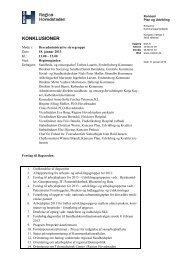Territorial Review Copenhagen - Region Hovedstaden
Territorial Review Copenhagen - Region Hovedstaden
Territorial Review Copenhagen - Region Hovedstaden
Create successful ePaper yourself
Turn your PDF publications into a flip-book with our unique Google optimized e-Paper software.
79<br />
most other OECD countries (OECD, 2007). Despite the importance of<br />
<strong>Copenhagen</strong> for the commercialisation of Danish research, the relations of<br />
universities with the business sector in <strong>Copenhagen</strong> are uneven. A survey<br />
carried out by FORA in 2008 indicated that the Danish Technical University<br />
and the IT University had a strong focus on interaction with the business<br />
community regarding the vocational relevance of educational courses, and<br />
that the Danish Technical University was engaged in extensive knowledgesharing<br />
with businesses. The University of <strong>Copenhagen</strong>, however, scored<br />
poorly to average on university-industry collaboration indicators (FORA,<br />
2008). Health, as researched by hospitals, is an important research area in<br />
<strong>Copenhagen</strong>; it has seen strong growth since 2000 and benefits from<br />
Denmark‘s extensive registers, which collect health and socio-economic<br />
data. Although the health sciences perform well in <strong>Copenhagen</strong> as compared<br />
to elsewhere in Europe, the career possibilities for young researchers are<br />
limited, forcing them to leave the field.<br />
Table 1.11. Share of Capital <strong>Region</strong> in commercialisation of research<br />
Capital <strong>Region</strong> share (%)<br />
Inventions 50<br />
Patent applications 54<br />
Licenses 58<br />
License income 77<br />
Source: Statistics Denmark<br />
Potential to be realised in the Øresund <strong>Region</strong><br />
The Øresund <strong>Region</strong> has great potential for synergies, but increased<br />
physical accessibility per se is not sufficient to realise the benefits of crossborder<br />
co-operation. This potential is to a large extent still unrealised with<br />
regards to innovation in the region. Scientific cross-border co-operation in<br />
the Øresund <strong>Region</strong> is still limited, by comparison with co-operation of<br />
actors in <strong>Copenhagen</strong> with those in other countries and in Stockholm. This<br />
can be illustrated by the regional distribution of co-publications in the<br />
Øresund <strong>Region</strong>. Co-authors in international joint publications are<br />
represented by scientists from a range of countries, particularly from<br />
Germany, the United Kingdom and the United States. About one-third of the<br />
firms have one or more publications with co-authors from outside Europe,<br />
while only one-fifth of the firms are involved in cross-border Danish-<br />
Swedish co-publications. Among the publications by the Danish Medicon<br />
Valley firms and co-authors in Sweden, around 40% are collaborations with<br />
co-authors in Stockholm, and 50% of co-publications with Swedish<br />
Medicon Valley firms and co-authors in Denmark are in the <strong>Copenhagen</strong><br />
<strong>Region</strong>. Although global co-operation is common in many universities,

















